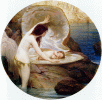
Established 1995
Phone: 703-683-2678

 Established 1995 Phone: 703-683-2678 |
 |
|
|
Types of PearlsNearly all pearls sold today are cultured pearls. Cultured pearls are a product of pearl farmers helping nature. Several inventors at the beginning of the 20th century discovered techniques of pearl cultivation. Cultured pearls can be from saltwater or freshwater mollusks. Pearl farmers introduce a shell bead into the oyster or mussel and the mollusk deposits layers of nacre around the bead. Many people use the term cultured pearls to refer only to pearls produced from saltwater oysters. However, the process to make freshwater pearls is the same. The correct usage is freshwater cultured pearls or saltwater cultured pearls. Cultured Saltwater Pearls
Saltwater cultured pearls come from the Akoya oyster (Pinctada fucata). Akoya oysters are also used by both the Japanese and the Chinese to produce saltwater cultured pearls. Akoya pearls are the most difficult to grow due to the low survival rates of the host oysters. Less than 5 in 10 will survive the nucleation process. Of the survivors, about 40% will successfully encircle the shell nucleus irritant with nacre. Overall, less than 5% of pearl output can be considered "high quality." At the center of every Japanese cultured pearl lies an American heart. Shell beads used as nuclei in the cultured pearl process come from freshwater mussels grown in the U.S. What's Killing the Oysters? from the Nova OnLine site. As of 2001, the blight that was killing Akoya oysters in Japan has stopped. Learn the difference between Akoya pearls from Japan and China. Visit Japanese Akoya Pearls vs. Chinese Akoya Pearls. Cultured Freshwater Pearls
Freshwater cultured pearls come from freshwater mussels and are produced by Japan, China, and The United States. The most famous type of freshwater cultured pearl is the Biwa (pronounced bee-wah) pearl which use to come from mussels grown in Lake Biwa, Japan’s largest freshwater lake. Because of pollution, production has stopped. Freshwater shell and pearl mussels are from the family Unionidae, from which about 20 different species are commercially harvested. The tones of the freshwater cultured pearls are dictated by the mother shell. White is the most common, followed by pink. Other colors depend on the type of mussels. Big washboard mussels (Megalonaias nervosa) usually have pink pearls, as do the wartyback mussel (Quadrula nodulata). Threeridge mussels (Amblema plicata) have pearls in shades of blue-green and lavender. Muckets (Actinonaias ligamentina) produce fine pink pearls, and sand mussel (Lasmigona costata) have salmon-pink pearls. Other mussels used to produce freshwater cultured pearls include the ebony, heelsplitter, pimple back, elephant ear, mapleleaf, three-ridge pigtoe, pistol grip, and butterfly. Pearl Oasis now offers the All-American Pearl Collection™, fine pearl jewelry made from pearls cultured in the lakes of Tennessee. These beautiful American freshwater pearls are grown longer than most Asian freshwater pearls. The longer culturing time means that the All-American Pearl has thicker nacre and a deeper luster. They are a better quality freshwater pearl. The settings used in the All-American Pearl Collection are designed and cast in the USA by American artisans. The All-American Pearl Collection™ currently includes rings, earrings and pendants. See our All-American Pearl Collection Page for more information. The Chinese freshwater pearl has greatly improved in quality in the last ten years. According to Fred Ward, one of the world’s most respected gemologist and author of a half dozen books on jewelry. More about Freshwater Pearls with pictures of the Chinese pearl farms that Pearl Oasis imports from. The Culture of Freshwater Pearls on the Nova Online cite. This is a very good description written by Fred Ward. Has some very nice pictures of the process. Natural Freshwater Pearls, U.S. Geological Survey. More information about the types of freshwater mussels that produce freshwater pearls can be found here. South Sea Pearls
South Sea pearls (also called White South Sea pearls) are saltwater pearls cultivated using the Pinctada maxima oyster (also called the silver lip or gold lip oyster), found in the South Seas (an area centered around Northern Australia and South-East Asia including Myanmar and Indonesia). They produce 10-20 mm pearls of silver or gold color. For centuries, pearl divers harvested these exotic shells for their valuable Mother of Pearl shell to make buttons. Occasionally pearls were found inside, and these pearls were regarded as a rare and valuable bonus. Information on The Pinctada maxima or Silver-Lipped oyster. Tahitian Black Pearls
Tahitian Black Pearls (also called South Sea Black pearls) are grown in the waters of French Polynesia. They are saltwater pearls from the Pinctada margaritifera or black-lipped oyster and can range from gray to black with red, green or blue overtones. This oyster also is found in the Cook Islands, Fiji, Tonga, Samoa, New Caledonia, the Philippines, Panama, and the Gulf of Mexico. An adult Pinctada oyster can reach a diameter of 30 centimeters, with weight exceeding 5 kilograms (over 10 pounds). Rare specimens as large as 9 kilograms (over 19 pounds), in fact, have been harvested. It takes about two years before the oyster ready for harvesting. Only about 30 percent of the oysters cultured produce a pearl. G.I.E. Perles de Tahiti is the Tahiti-located official promotional organization for Tahitian black pearls. This site is loaded with information. Information on The Pinctada Margaritafera or Black Lipped Oyster. Mabe Or Blister Pearls
Mabe Pearls are assembled from a cultured blister pearl produced by the Pteria penguin and Pteria sterna oysters (Black-winged and White-winged Pearl Oyster). Most come from Japan, Indonesia, or Australia. A large half bead is attached to the inside of the shell between the epithelial mantle of the mother-of-pearls and the animal's internal shell. The blister pearl that is produced is cut from the shell and the hollow inside is filled with wax or glue. A mother-of-pearl backing is often added. More information can be found here.
|
Pearl Oasis |

|